The large experiments in particle physics are not just key to our understanding of the Universe, but also outstanding in themselves and impressive technological achievements. CERN is the largest and leading laboratory for particle physics in Europe and houses a complex system of various accelerators and detectors that image particle collisions like gigantic cameras. In addition to searching for the fundamental building blocks of our Universe, CERN is generating rare isoptopes for
scientific and medical purposes, produces and manipulates anti-matter or investigates the importance of cosmic rays in the the formation of clouds. CERN is also centre to challenging tasks in data analysis, the use of high performance computersor the networking and distribution of information. These ultimately have brought about developments such as the World Wide Web.
Students and young scientists at the University of Graz who specialize in particle physics, as part of an excursion the lecture "Collider Phenomenology", had the unique opportunity to to visit some of the experiments and facilities at CERN on site, and CERN scientists walked them through the various activities and experiments. Simon Plaetzer, who gave the lecture and as a particle physicist himself actively works with researchers CERN was very pleased that this was possible:
“This was certainly an exceptional visit far beyond what is normally possible for visitors. I am very grateful to my Austrian colleagues at CERN which made this excursion possible.” It was a lucky coincidence that the annual visit took place a few days after the winter shutdown of the accelerators was initiated, and so areas were accessible which could not be viewed during ongoing operations.
The students stayed in the CERN guest house and so were able to get a gist of “live” laboratory air. Together with Platzer, they visited some smaller accelerators and storage rings such as LEIR (Low Energy Ion Ring), AD (Aniproton Decellerator) and ELENA (Extra Low Energy Antiproton Ring), experiments on antimatter (in which the Stefan Meyer Institute of the OeAW is involved), with ALICE and CMS two of the four large detectors at the flagship accelerator LHC (on which the
Institute for High Energy Physics of the CAW is involved). The CERN data center, as well as the newly opened “Science Gateway” had also been on the menu. The students were welcomed by Manfred Krammer, the head of the Experimental Physics Departments at CERN, originally working at HEPHY of the OeAW.
The University of Graz has the largest group for Theoretical particle physics in Austria. For the students of theoretical particle physics it is important to also have contacts to experimental methods and see how theoretical approaches, precise calculations and simulations are tested experimentally. However, CERN doesn't exclusively host experiments. It also is home to one of the world's most recognized theory groups. At the end of the visit a special highlight for the students from Graz was an informal discussion lasting over an hour with colleagues from the CERN Theory Department about current challenges and opportunities in theoretical particle physics. In addition to a recent initiative of including Collider Physics and experimental particle physics as part of the curriculum of physics education in Graz, the training of particle physics students at Graz will further profit from continuing these excursions to CERN.
Tuesday, 21 January 2025
From the building blocks of the universe to manipulation with antimatter



